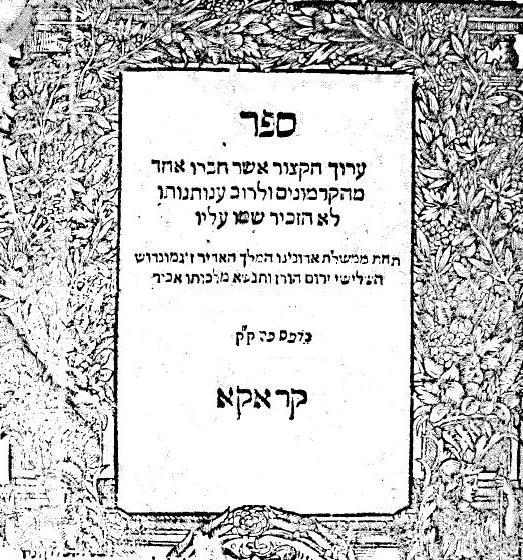The first significant Talmudic University in Kraków was founded around 1503 by Jakub Polak. The needs of Jewish education and Talmudic teaching led to the development of printing in the former Republic of Poland, although as late as the second half of the 16th century copies of the Talmud were still a real rarity there, and manuscripts or prints were possessed only by yeshiva rectors.
Polish Jews lived strictly according to the ritual-religious regulations contained in the Torah and Talmud, and an autonomous Jewish judiciary issued sentences in cases between Jews on the basis of Talmudic law. With the development of yeshivas, rabbinic literature flourished in the Republic of Poland. The boom also included works on the philosophy of religion, ethics, homiletics and didactics. It appeared mainly in the form of commentaries on the Talmud and Talmudic codes. In addition, there were works related to the so-called practical Kabbalah.
In 1534, in Kazimierz, near Krakow, the brothers Samuel, Asher and Eljakim Helic, sons of Chaim of Halicz, founded the first Jewish printing house in Poland and published the first book in the Jewish language – a work by Rabbi Asher Ancla Mirkewt Hamishne, intended for fathers of families to learn Hebrew. After three years of activity, the brothers were baptised and closed the printing house due to the boycott of the Jewish community.
Around 1547, a printing house was established in Lublin by Chaim Shachor, who had previously been a printer in Prague, Augsburg, Ichenhausen, Heddernheim near Frankfurt am Main. The initiative had a great chance of success, as Lublin was not only home to one of the best and most famous yeshivas in Poland, but also hosted famous and internationally renowned fairs that attracted large numbers of Jews, who also had a fair court there from as early as 1540.
In 1550, King Sigismund Augustus granted a privilege to open a Jewish printing house in Lublin to Yitzhak ben Chaim and Yosef ben Yaakov, who printed, among other things, a prayer book for the whole year according to the Ashkenazi rite. Soon, new typographical equipment was brought to the Lublin printing house from Prague, which enabled the printing of the first edition of the “Babylonian Talmud” in Lublin in 1559-1577. Until the opening of a new and qualitatively better Jewish printing house in Kraków in 1568, owned by Yitzhak ben Aaron Prostic, Lublin was the centre of Jewish printing in Poland for several years. In the 1570s and 1680s, translations of selected books of the Old Testament were published in Kraków: in 1586, the Book of Isaiah and the Psalms were translated by Moses Stendal. In 1622, the third Kraków edition of the most widely read Yiddish book for women, Cene urene (Go out and look), written by Rabbi Jacob Ashkenazi of Janow, was printed.
Between the second half of the 16th century and the middle of the 17th century, four editions of the Talmud and single treatises were published in the Lublin and Kraków printing houses. Romances of chivalry and bourgeois romances translated into Yiddish, such as “The Story of the Adventures of Theodoric of Verona”, also gained considerable popularity as well as moral tales.
Among the rabbinic literature published in this period, experts distinguish apologetic and polemical works. Among polemicists in the 16th century, Jakub of Bełżyce, an expert in rabbinic, Arian, Catholic and Protestant literature, became famous for his defence of Judaism, polemising with Marcin Czechowicz, a representative of the Polish Brethren. It should be mentioned that Jews had a very personal attitude to books, they were treated as written by divine inspiration, so when they were no longer usable, they were buried as if they were someone close to family.
Works related to the practical Kabbalah became popular thanks to Isaac Luria Ashkenazi (1534-1572), who lived in Palestine and who claimed that Kabbalists could influence phenomena in nature and society through the magical power of the biblical text. The best-known representative of this trend among Polish Jews became Jezajasz Horowic of Kazimierz, who proclaimed ideas of mysticism and asceticism in his work Shna Luchot Habrit (Two Tablets of the Covenant), published in Kraków. However, the time of the popularity of practical Kabbalah among Polish Jews did not come until the second half of the 17th century, after the disasters that befell them during the Chmielnicki Uprising and the Swedish Deluge.





